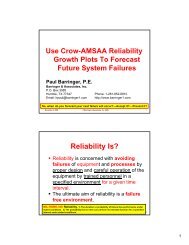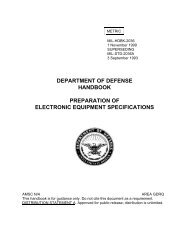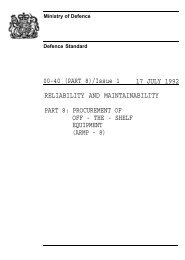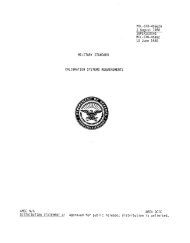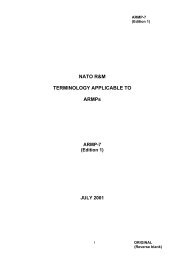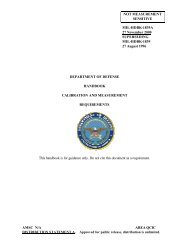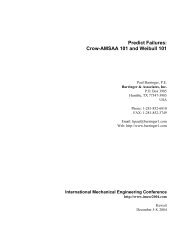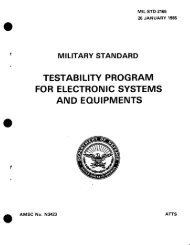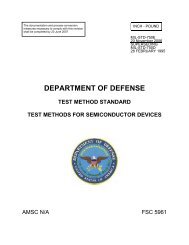MIL-STD-1629-RevA - Barringer and Associates, Inc.
MIL-STD-1629-RevA - Barringer and Associates, Inc.
MIL-STD-1629-RevA - Barringer and Associates, Inc.
You also want an ePaper? Increase the reach of your titles
YUMPU automatically turns print PDFs into web optimized ePapers that Google loves.
M1l.-<strong>STD</strong>-l629A50.4 FFfECA-maintainability information (task 103). The FMECAmaintainabilityinformation analysis is ut~l~zed to provide early designcriteria for test methods, accessibility, <strong>and</strong> repairability for the itembeing analyzed. This analysis is an extension of the FMEA <strong>and</strong> is dependentupon FMEA generated information; therefore, the FMECA-maintainabilityinformation analyses should not be imposed without imposition of theFMEA . The identification of how each failure will be detected <strong>and</strong>localized by the operational level maintenance technician will provideinformation for evaluating the effectiveness of built-in-test. Descriptionsof the basic organizational level maintenance actions required forfailure localization <strong>and</strong> correction will identify Potential accessibilityproblems permitting early design correction. Th; failure mode listingwhich is included on the completed worksheets should be utilized to.provide this required data for both the maintenance plan <strong>and</strong> logisticssupport analyses.50.5 DMEA (task 104). The DMEA provides essential inputs forthe vulnerability assessment of a weapon system to aid in the identificationof deficiencies <strong>and</strong> the evaluation of designs for enhancing survivability.Since the DMEA utilizes the failure mode information from the FMEA, itshould not be imposed without imposition of the FMEA. The DMEA, likethe initial FMEA, should be done early in the conceptual phase to providedata related to the capability of the conceptual weapon system design LOsurvive the effects of the specified hostile Lllreats. Development ofthis data before weapon system design configuration is finalized willprovide significant survivability benefits with minimal impact on cost<strong>and</strong> schedule.50.6 Criticality number (C=) calculation example. Calculationof meaningful criticality numbers requires the use of specific failurerate <strong>and</strong> part configuration data. When part configurations are known,failure rate data can be obtained from the appropriate reliabilityprediction, field data from past systems of similar design <strong>and</strong> environment,?luse, or failure rate data sources such as <strong>MIL</strong>-HDBK-217. With knownfailure rates, the criticality number for an item is the number offailures of a specific type expected per million hours due to the item’sfailure modes under a particular severity classification as discussed jnTask 101. A failure mode criticality number, ~, for a particularseverity classification is given by the expression:(1)The item criticality number, CrJ under n particular sever~~y cl,lssifjcation,is then calculated by summing the Cm for each failure mode under thatseverity classification. This summation is given by the expressions:jcr=~ (Cm)n orn=]cr=z-jn= 16fl~lpt X i(l )n R = 1,2,3, ...j (2).-. .



